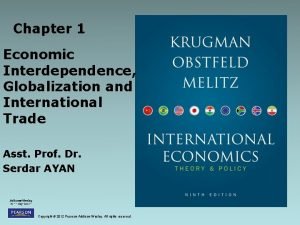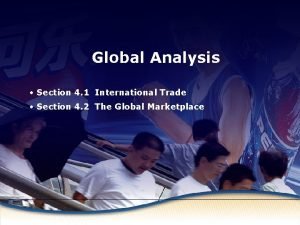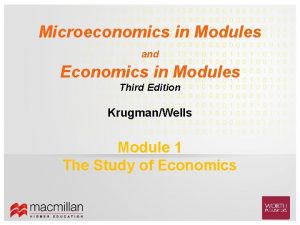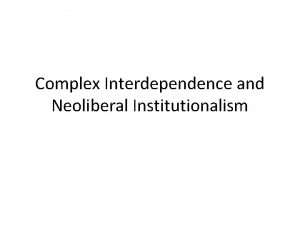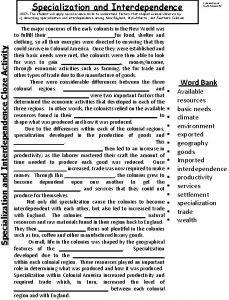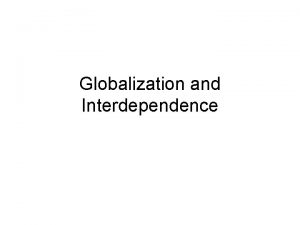SinoJapanese Economic Issues Interdependence on a Deeper Level














- Slides: 14

Sino-Japanese Economic Issues: Interdependence on a Deeper Level Fred Taylor

Hypothesis Liberal International Relations Theory says: Economic Interdependence Security Cooperation My Research Question: Will Interdependencies Lead to Diplomatic Cooperation? Step 1: Economic Interdependence Increase Cost of Conflict Increased Empathy Step 2: Increased Empathy Diplomatic Cooperation Security Cooperation

Outline • Economic Trends – Bilateral Trade – FDI • South and SEA Rivalry – Financial Integration • Foreign Exchange • Energy and Ecological Interdependence • Prospects in 2027 • Conclusions (So What? ) Wen-Abe Summit: 11 -13 April 2007 – Linkages to Security and Diplomatic Policy

Sino-Japanese Trade Statistics • China by the numbers – – – • Japan by the numbers GDP: $2. 512 Trillion Trade Total: 1. 75 Trillion %GDP Total: 69% %GDP w/ Japan: 8% %GDP w/ U. S. : 10% • U. S. Stats show larger % – Flows w/ Japan: -$24 B – Flows w/ U. S. : $232. 6 B • Import: Raw Materials • Export: Manufactured Goods – – GDP: $4. 365 Trillion Trade Total: $1. 02 Trillion %GDP Total: 23% %GDP w/ China: 4. 7% • With Hong Kong included – %GDP w/ U. S. : 4. 1% – Flows w/ China: $26 B – Flows w/ U. S. : $88. 4 B • Import: Food, Airplanes • Export: Cars, Car Parts Bottom line: China is highly dependent on world trade Japan also net-importer food, fuel

Direction of Trade China Top 5 Imports Exports EU 90. 3 Hong Kong Japan Top 5 Imports Exports 182. 0 Total ($ B) 272. 3 U. S. 58. 9 123. 3 Total ($ B) 182. 2 107. 4 155. 4 262. 8 China 73. 6 99. 8 173. 4 U. S. 59. 2 203. 5 262. 7 Korea 22. 5 42. 9 65. 4 Japan 115. 8 91. 8 207. 6 ROC 16. 6 40. 0 56. 6 ASEAN 89. 5 71. 3 160. 8 Thai land 14. 3 20. 6 34. 9 China Monthly Statistics: 2006 Japan Statistic Bureau (MOF): 2005 Take Away: Increased trade also increases trade friction

Foreign Direct Investment (FDI) • China’s FDI Total: $53 B • FDI from Japan: $28. 2 B • Investment Frictions – Foreign Invested Enterprises account for %58 of exports • “Economic Colonialism” – Japanese “hollowing out” • Suzuki Motorcycles – Emotion trumps Economics • Mori Building in Shanghai • Maglev vs. Bullet Train • Sino-Japanese Competition for SEA Influence • Chinese Foreign Exchange Investment Bank – Build Domestic Economy, Less Dependent on FDI

Financial Integration (w/ U. S. Market) • Foreign Exchange reserves – China: $1. 30 Trillion – Japan: $. 895 Trillion • Economist Intelligence Unit CRS Report RL 32165 (’ 06) • Integration After 1997 Asian Financial Crisis – Asian Monetary Fund (AMF) – Chiang Mai Initiative • “Dollar Zone” Bottom line: U. S. economic integration doesn’t directly correspond to Sino-Japanese integration

Energy Interdependence • Nuclear Capacity – Japan: 55 plants – China: 4 plants • Energy Efficiency – Japan: 37% – China: 9% • Japan’s Options – – – Nuclear Energy Conservation Renewable Energy East China Sea Siberia-Pacific Pipeline • China’s Options – – – Coal Hydro electric Central Asian Pipeline East China Sea Siberia-Pacific Pipeline

Ecological Interdependence Asian dust brings hazy skies to western U. S. USA Today 04/18/2001 AP/NASA/Goddard Space Flight Center Pollution over China Blows out to Sea October 22, 2004

Official Developmental Assistance • Japan ODA to China: $30 B • Japan voted to stop low-interest loans in 2008 • Grant-Aid will continue beyond 2008 International Nuclear Safety Center, March, 1999

Sino-Japanese Relations in 2027 • Goldman Sachs BRIC Report 2050 – Models based on: labor, capital stock, and TFP – Continued growth based on: • • Macro-Economic Stability Openness to Trade and Investment Efficient Institutions Enhanced Education Levels • Japan’s Challenges – Graying and Shrinking Population – Debt (150% of GDP), Economic Reforms Needed • China’s Challenges – Environment, Corruption, Social Safety Net MP: China’s prospects for growth better than Japan’s

So What? • Conclusion: Economic and Ecological Interdependence Will Remain Strong for the Next Two Decades, but So What? – Economic Linkages to Security are Weak • Regime survival and “lost child” more important than $$ – Economic Linkages to Politics are Arbitrary • Can sometimes “buy” good will, sometimes not • Not a guarantee for “peace” in the region, but rather an incentive to maintain economic stability – If China perceives she is winning the “great game, ” then she will likely preserve future good relations with Japan and the U. S.

Conclusion Liberal International Relations Theory says: Economic Interdependence Security Cooperation My Research Question: Will Interdependencies Lead to Diplomatic Cooperation? Complex Interdependencies May Positively Affect Diplomatic Cooperation Sometimes Step 1: Economic Interdependence Increase Cost of Conflict Increased Empathy Step 2: Increased Empathy Diplomatic Cooperation Security Cooperation

Questions? Wen-Abe Summit: 11 -13 April 2007
 Into the heart of jesus deeper and deeper i go
Into the heart of jesus deeper and deeper i go Economic interdependence pros and cons
Economic interdependence pros and cons Economic interdependence
Economic interdependence How does rentals affect filipino entrepreneurs?
How does rentals affect filipino entrepreneurs? What is economics
What is economics Economic growth vs economic development
Economic growth vs economic development What is economic growth and development
What is economic growth and development Chapter 1 lesson 2 our economic choices worksheet answers
Chapter 1 lesson 2 our economic choices worksheet answers Go deeper in christ
Go deeper in christ Deeper life bible church netherlands
Deeper life bible church netherlands Dclm netherlands
Dclm netherlands Deeper life bible church netherlands
Deeper life bible church netherlands Deeper life netherlands
Deeper life netherlands Deeper
Deeper Deeper life messages
Deeper life messages

